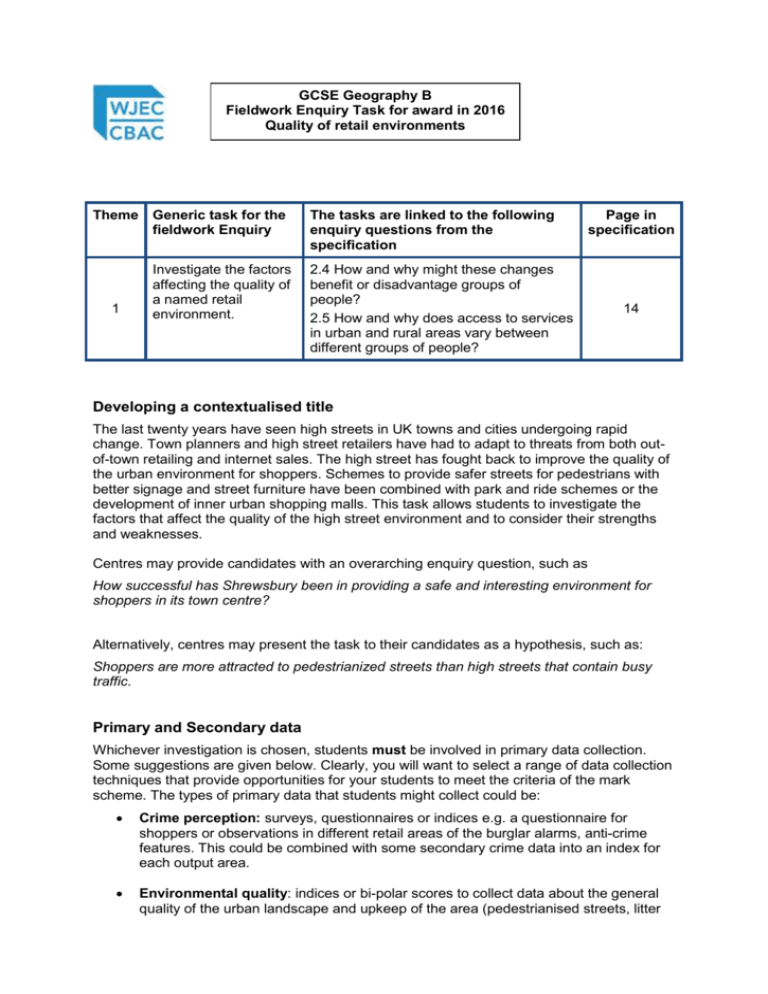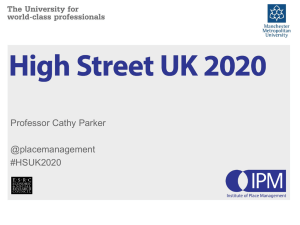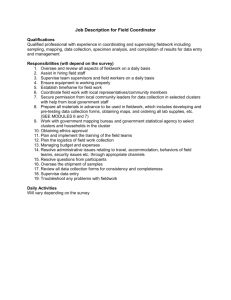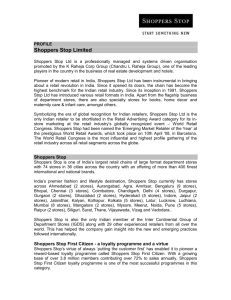GCSE - WJEC
advertisement

GCSE Geography B Fieldwork Enquiry Task for award in 2016 Quality of retail environments Theme Generic task for the fieldwork Enquiry 1 Investigate the factors affecting the quality of a named retail environment. The tasks are linked to the following enquiry questions from the specification 2.4 How and why might these changes benefit or disadvantage groups of people? 2.5 How and why does access to services in urban and rural areas vary between different groups of people? Page in specification 14 Developing a contextualised title The last twenty years have seen high streets in UK towns and cities undergoing rapid change. Town planners and high street retailers have had to adapt to threats from both outof-town retailing and internet sales. The high street has fought back to improve the quality of the urban environment for shoppers. Schemes to provide safer streets for pedestrians with better signage and street furniture have been combined with park and ride schemes or the development of inner urban shopping malls. This task allows students to investigate the factors that affect the quality of the high street environment and to consider their strengths and weaknesses. Centres may provide candidates with an overarching enquiry question, such as How successful has Shrewsbury been in providing a safe and interesting environment for shoppers in its town centre? Alternatively, centres may present the task to their candidates as a hypothesis, such as: Shoppers are more attracted to pedestrianized streets than high streets that contain busy traffic. Primary and Secondary data Whichever investigation is chosen, students must be involved in primary data collection. Some suggestions are given below. Clearly, you will want to select a range of data collection techniques that provide opportunities for your students to meet the criteria of the mark scheme. The types of primary data that students might collect could be: Crime perception: surveys, questionnaires or indices e.g. a questionnaire for shoppers or observations in different retail areas of the burglar alarms, anti-crime features. This could be combined with some secondary crime data into an index for each output area. Environmental quality: indices or bi-polar scores to collect data about the general quality of the urban landscape and upkeep of the area (pedestrianised streets, litter bins, litter, traffic calming, benches, signage etc.). Students could combine this with photos that they take of the worst and the best images in each category. Questionnaires: data about different aspects of the quality of the retail environment e.g. views on parking, public transport, park and ride, pedestrian access, safety perception crime / traffic / pollution etc. Town centre service surveys: e.g. libraries, post-offices, parking, health. Transport index: create an index which combines the frequency, length and cost of public transport to the town centre. Extended interviews: for example with groups who might be involved in public transport, chamber of trade, town centre planning or retailing. Photographic evidence: photos could be taken of the various areas within the region and annotated to take note of the building / environment / traffic / people / services / renewal schemes / upkeep etc. Or perhaps a photo that students think sums up the area – socially or economically. It should be remembered that some primary data gathering through surveys and questionnaires can be considered as “snapshots”, and could be affected by different times of day, week, year etc. Secondary data sources which would be helpful for this task would include: Blank site maps or land use maps from local planning office of the Local Authority Satellite images showing overall layout of the retail area Local Urban District Plans can provide insight into decision-making on retail environments There may be local neighbourhood groups, consumer organisations, welfare groups etc. who produce information or materials advising about retail environment design How to encourage independent thought: Time should be allowed for students to become involved in the planning process before the fieldwork is conducted. Students should be encouraged to contribute to discussions about data collection and sampling techniques. Student guidance sheets should be designed with suggestions to prompt independence, for example, whilst all students are involved in some data collection, students could also be given the opportunity to select one additional data collection technique. As well as answering the main contextualised title students could choose from a suggested selection of guiding questions to investigate the data further: E.g. how might the survey results change according to time of day/week/year? Are some types/groups of shoppers happier with the retail environment than others? What can be done to improve the retail experience for the more vulnerable shopper? What role is played by the design and layout provided by major retailers? Does the area operate a “shopmobility” or “Dial-a-ride” scheme? How do you suggest this retail environment could be improved? AO2 Application The mark scheme criteria for AO2 should be checked thoroughly when designing the fieldwork enquiry. Students will be able to access higher marks for AO2 if they link their observations and investigations to a wider knowledge of other retail environments. For example, some consideration as to whether the contextualised location is typical or atypical is a productive line of analysis for AO2. More able students might be expected to apply theories and concepts related to retail habits, sympathetic landscaping and design, social/demographic trends in shopper activity, public crime prevention schemes and transport network innovation (tram links etc.) to the locality they have studied in their fieldwork. The issue of geographical futures should also be addressed, with higher level candidates seeking to ask and address a range of questions related to how this retail environment can be thought of as dynamic and subject to change, and why. Useful Web-links http://www.rgs.org/OurWork/Schools/Fieldwork+and+local+learning/Fieldwork+techniques/U rban+and+settlement.htm The RGS has a useful guide to fieldwork examining retail distribution. Take care – this webpage also describes how retail change can be investigated, such a study is not appropriate in 2016. . http://www.checkmyfile.com/postcode-check/SY5-9PR.htm Postcode code data including, house prices, social grades, crime rates etc. http://www.bing.com/maps/ Maps and air photos using a postcode search. http://www.geograph.org.uk/ Photos of every OS grid square.







